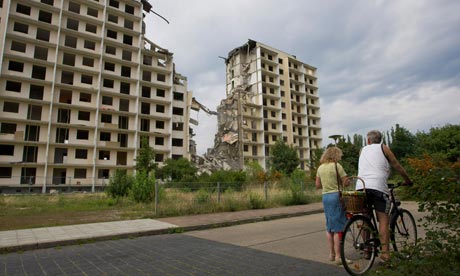
On the windswept roof of the Lausitz Tower, the town's only landmark, I meet Felix Ringel. A young German anthropologist studying at Cambridge University, he has passed up chances taken by his friends to investigate the rituals of Amazon tribes or Mongolian peasants. As we survey the empty plots of fenced scrub below, he explains that the underbelly of his own country seemed weirder and far less studied than those exotic worlds.In its heyday in the 60s, Hoyerswerda was a model community in communist East Germany, a brave new world attracting migrants from all over the country. They dug brown coal from huge open-cast mines on the plain around the town. There was good money and two free bottles of brandy a month. But the fall of the Berlin Wall changed all that.
...
Under communism, East German women worked more, and were often better educated, than the more conservative western hausfrau. But when their jobs disappeared in the early 90s, hundreds of thousands of them, encouraged by their mothers, took their school diplomas and CVs and headed west to cities such as Heidelberg. The boys, however, seeing their fathers out of work, often just gave up. In adulthood, they form a rump of ill-educated, alienated, often unemployable men, most of them unattractive mates – a further factor in the departure of young women.
...
"There has been nothing comparable in world peacetime history," says the French demographer Jean-Claude Chesnais. After the Berlin Wall came down, millions of East Germans who stayed behind decided against producing another generation. Their fertility more than halved. In 1988, 216,000 babies were born in East Germany; in 1994, just 88,000 were born. The fertility rate worked out at 0.8 children per woman. Since then it has struggled up to around 1.2, but that is still only just over half the rate needed to maintain the population. About a million homes have been abandoned, and the government is demolishing them as fast as it can. Left behind are "perforated cities", with huge random chunks of wasteland. Europe hasn't seen cityscapes like this since the bombing of the second world war.
And nowhere has emptied as much as Hoyerswerda. In the 80s, it had a population of 75,000 and the highest birth rate in East Germany. Today, the town's population has halved. It has gone from being Germany's fastest-growing town to its fastest-shrinking one. The biggest age groups are in their 60s and 70s, and the town's former birth clinic is an old people's home. Its population pyramid is upturned – more like a mushroom cloud.
In a school in a partly demolished suburb known simply as Area Nine, I meet Nancy, a tattooed and quietly spoken social worker. Forty years ago, her parents were among the newcomers: her mother was a midwife, her father a train driver. "There were modern flats and services here then. It was a prestige development. When you asked the kids what they wanted to do when they grew up, they had ambitions to drive buses or work in the power station. But now parents find it very difficult to encourage their children when they have no jobs or prospects themselves. My friends have all left. I'd like to stay, but I have a three-year-old daughter and the schools are no good any more. I'll probably go too."
...
Across the rest of Germany, Hoyerswerda is regarded as a feral wasteland – complete with wolves. Slinking in from Poland and the Czech Republic, they are finding empty spaces where once there were apartment blocks and mines. And the wolves, at least, are staying. A few kilometres down the road, near the tiny town of Spreewitz, wolf enthusiast Ilka Reinhardt can't believe his luck: "We have more wolves than we have had in 200 years." The badlands of former East Germany are going "back to nature". And Europeans should be worried, for some fear that eastern Germany is, as it was back in the 1960s, a trailblazer for the demographic future of the continent.
This is definitely an interesting phenomenon, but strangely I am not moved. First, the traditional population of Europe may be falling, or look like it's about to fall, but the population of the world is still going up, with devastating impacts on climate and the rest of the environment. If Europeans don't want to devote their lives to aggravating the problem, who am I to tell them that they should?
Also, there are sizable parts of North America where the population is thinning out pretty drastically, too. Canada and the United States both have growing populations, but the places where people used to support themselves by breaking the sod or digging mines by hand are clearing out and these areas may well end up with populations of the scale that existed before the huge invasion from Europe. Remember that huge invasion from Europe? That took place because Europe could not support its population under decent conditions with technology and institutions of the time. I am not so sure why people get so excited about this stuff, but it may have something do with the fear of slang-speaking kids wearing baseball caps backwards.
Me, my neighborhood has both wolves and kids with baseball caps worn at various angles. So what.
Image: This is Hoyerswerda.
This is hardly new. Detroit has lost two thirds of its population. New Orleans more, but then, they have an excuse....grin!
ReplyDeletehttp://michiganmessenger.com/22062/detroit-leads-nation-in-population-loss
http://detnews.com/article/20090402/METRO/904020403/Leaving-Michigan-Behind--Eight-year-population-exodus-staggers-state